BMA314 Organizational Change Management Report: Uni of Hard Knocks
VerifiedAdded on 2023/03/17
|14
|3593
|42
Report
AI Summary
This report examines organizational change management strategies for the University of Hard Knocks, addressing challenges and opportunities. It analyzes the need for change, particularly focusing on the amalgamation of institutions, marketing, and faculty restructuring. The report applies change models such as Kurt Lewin's and McKinsey 7S, justifying the need for change to improve reputation and adapt to market pressures. It also details communication strategies, addressing potential issues, barriers, and ethical considerations. The report emphasizes the importance of effective communication and the application of various models to facilitate successful organizational change within the university context.
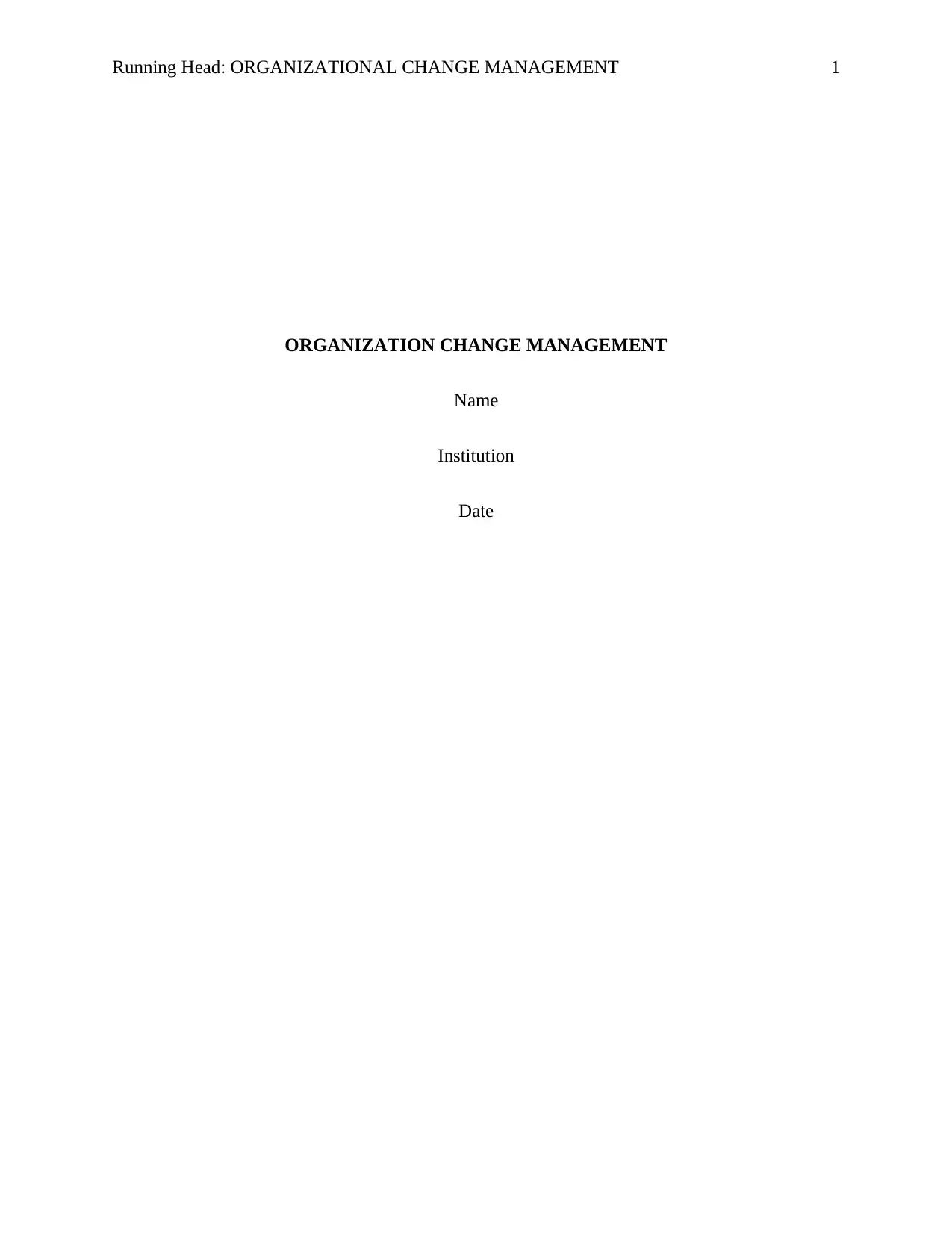
Running Head: ORGANIZATIONAL CHANGE MANAGEMENT 1
ORGANIZATION CHANGE MANAGEMENT
Name
Institution
Date
ORGANIZATION CHANGE MANAGEMENT
Name
Institution
Date
Paraphrase This Document
Need a fresh take? Get an instant paraphrase of this document with our AI Paraphraser
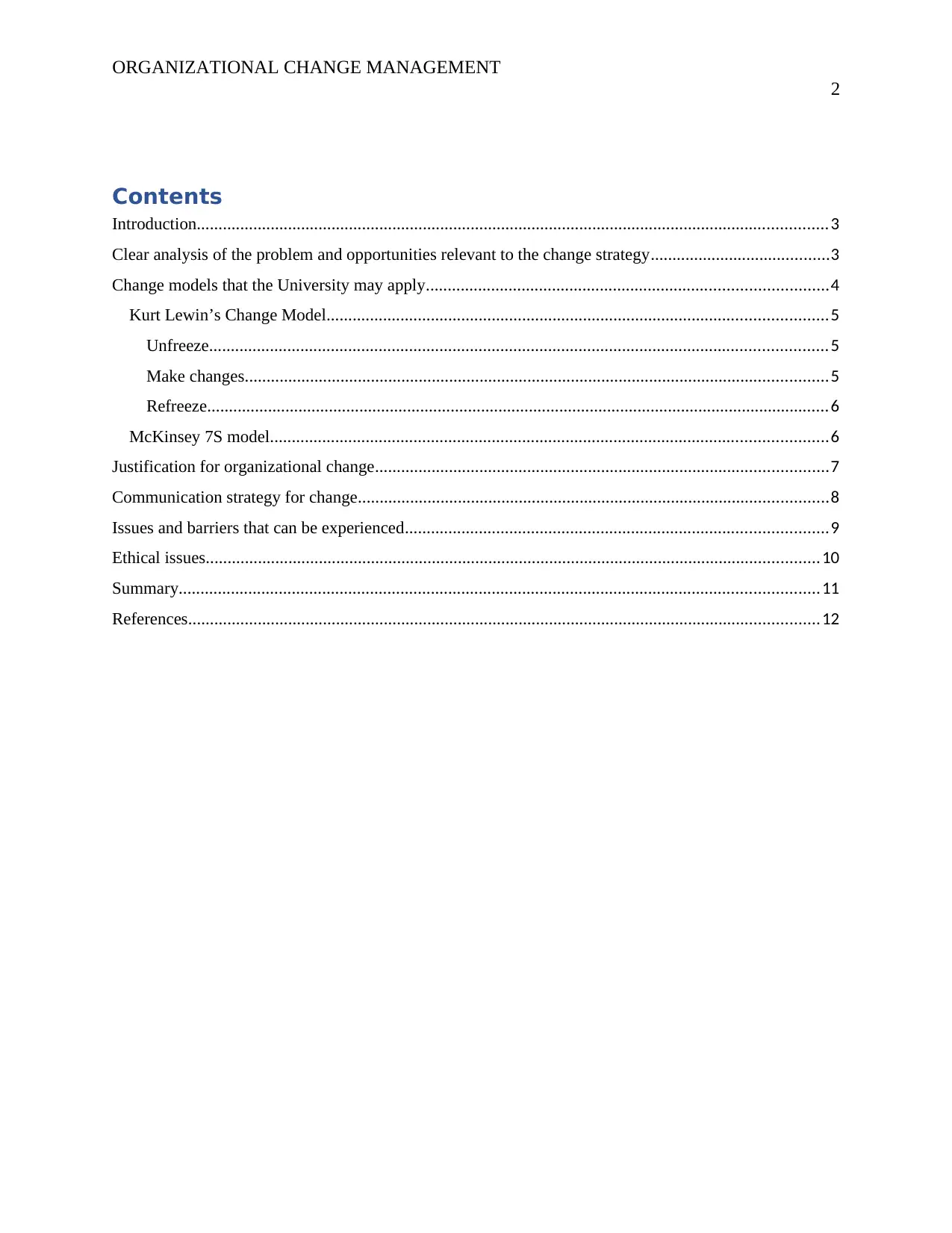
ORGANIZATIONAL CHANGE MANAGEMENT
2
Contents
Introduction.................................................................................................................................................3
Clear analysis of the problem and opportunities relevant to the change strategy.........................................3
Change models that the University may apply............................................................................................4
Kurt Lewin’s Change Model...................................................................................................................5
Unfreeze..............................................................................................................................................5
Make changes......................................................................................................................................5
Refreeze...............................................................................................................................................6
McKinsey 7S model................................................................................................................................6
Justification for organizational change........................................................................................................7
Communication strategy for change............................................................................................................8
Issues and barriers that can be experienced.................................................................................................9
Ethical issues.............................................................................................................................................10
Summary...................................................................................................................................................11
References.................................................................................................................................................12
2
Contents
Introduction.................................................................................................................................................3
Clear analysis of the problem and opportunities relevant to the change strategy.........................................3
Change models that the University may apply............................................................................................4
Kurt Lewin’s Change Model...................................................................................................................5
Unfreeze..............................................................................................................................................5
Make changes......................................................................................................................................5
Refreeze...............................................................................................................................................6
McKinsey 7S model................................................................................................................................6
Justification for organizational change........................................................................................................7
Communication strategy for change............................................................................................................8
Issues and barriers that can be experienced.................................................................................................9
Ethical issues.............................................................................................................................................10
Summary...................................................................................................................................................11
References.................................................................................................................................................12
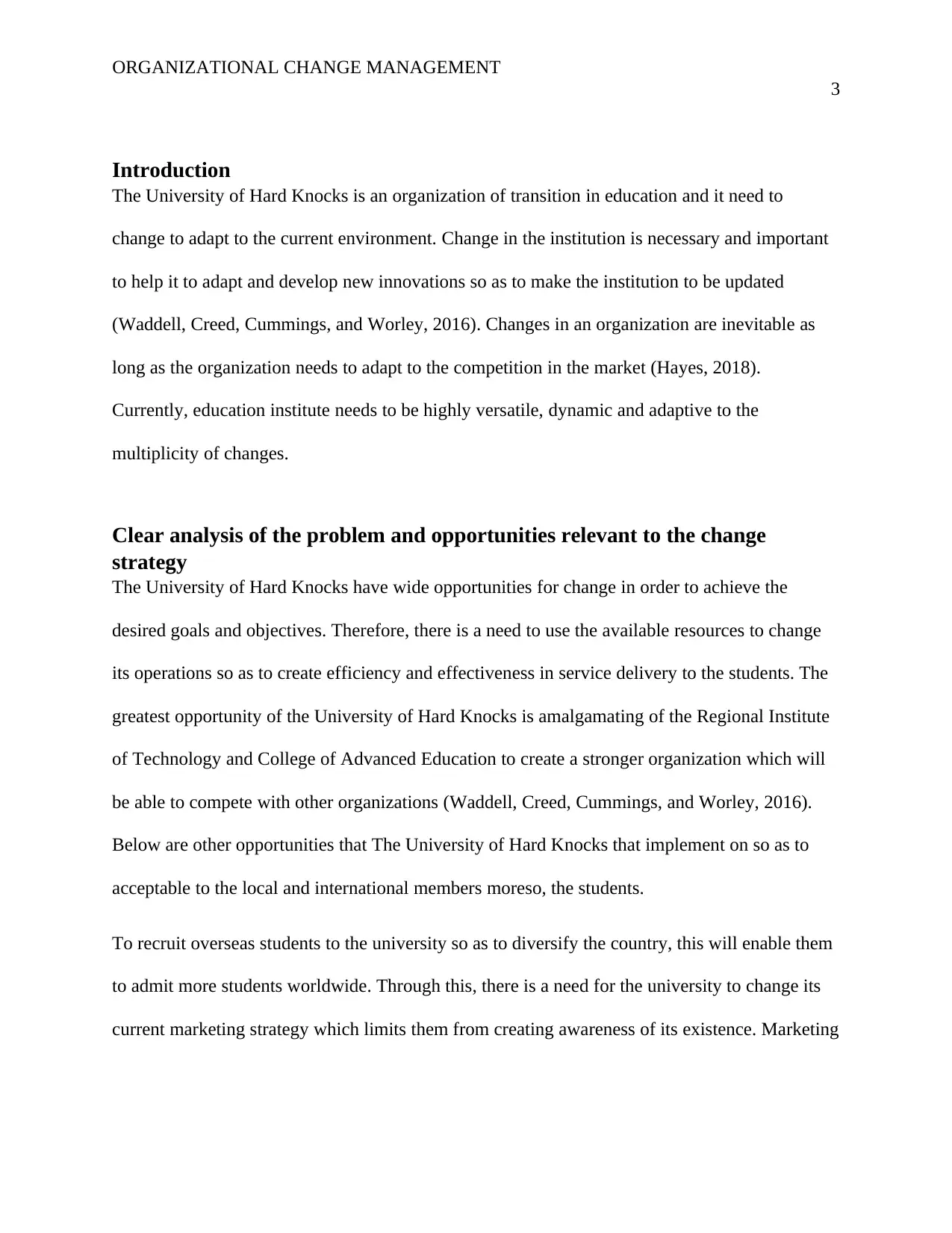
ORGANIZATIONAL CHANGE MANAGEMENT
3
Introduction
The University of Hard Knocks is an organization of transition in education and it need to
change to adapt to the current environment. Change in the institution is necessary and important
to help it to adapt and develop new innovations so as to make the institution to be updated
(Waddell, Creed, Cummings, and Worley, 2016). Changes in an organization are inevitable as
long as the organization needs to adapt to the competition in the market (Hayes, 2018).
Currently, education institute needs to be highly versatile, dynamic and adaptive to the
multiplicity of changes.
Clear analysis of the problem and opportunities relevant to the change
strategy
The University of Hard Knocks have wide opportunities for change in order to achieve the
desired goals and objectives. Therefore, there is a need to use the available resources to change
its operations so as to create efficiency and effectiveness in service delivery to the students. The
greatest opportunity of the University of Hard Knocks is amalgamating of the Regional Institute
of Technology and College of Advanced Education to create a stronger organization which will
be able to compete with other organizations (Waddell, Creed, Cummings, and Worley, 2016).
Below are other opportunities that The University of Hard Knocks that implement on so as to
acceptable to the local and international members moreso, the students.
To recruit overseas students to the university so as to diversify the country, this will enable them
to admit more students worldwide. Through this, there is a need for the university to change its
current marketing strategy which limits them from creating awareness of its existence. Marketing
3
Introduction
The University of Hard Knocks is an organization of transition in education and it need to
change to adapt to the current environment. Change in the institution is necessary and important
to help it to adapt and develop new innovations so as to make the institution to be updated
(Waddell, Creed, Cummings, and Worley, 2016). Changes in an organization are inevitable as
long as the organization needs to adapt to the competition in the market (Hayes, 2018).
Currently, education institute needs to be highly versatile, dynamic and adaptive to the
multiplicity of changes.
Clear analysis of the problem and opportunities relevant to the change
strategy
The University of Hard Knocks have wide opportunities for change in order to achieve the
desired goals and objectives. Therefore, there is a need to use the available resources to change
its operations so as to create efficiency and effectiveness in service delivery to the students. The
greatest opportunity of the University of Hard Knocks is amalgamating of the Regional Institute
of Technology and College of Advanced Education to create a stronger organization which will
be able to compete with other organizations (Waddell, Creed, Cummings, and Worley, 2016).
Below are other opportunities that The University of Hard Knocks that implement on so as to
acceptable to the local and international members moreso, the students.
To recruit overseas students to the university so as to diversify the country, this will enable them
to admit more students worldwide. Through this, there is a need for the university to change its
current marketing strategy which limits them from creating awareness of its existence. Marketing
⊘ This is a preview!⊘
Do you want full access?
Subscribe today to unlock all pages.

Trusted by 1+ million students worldwide
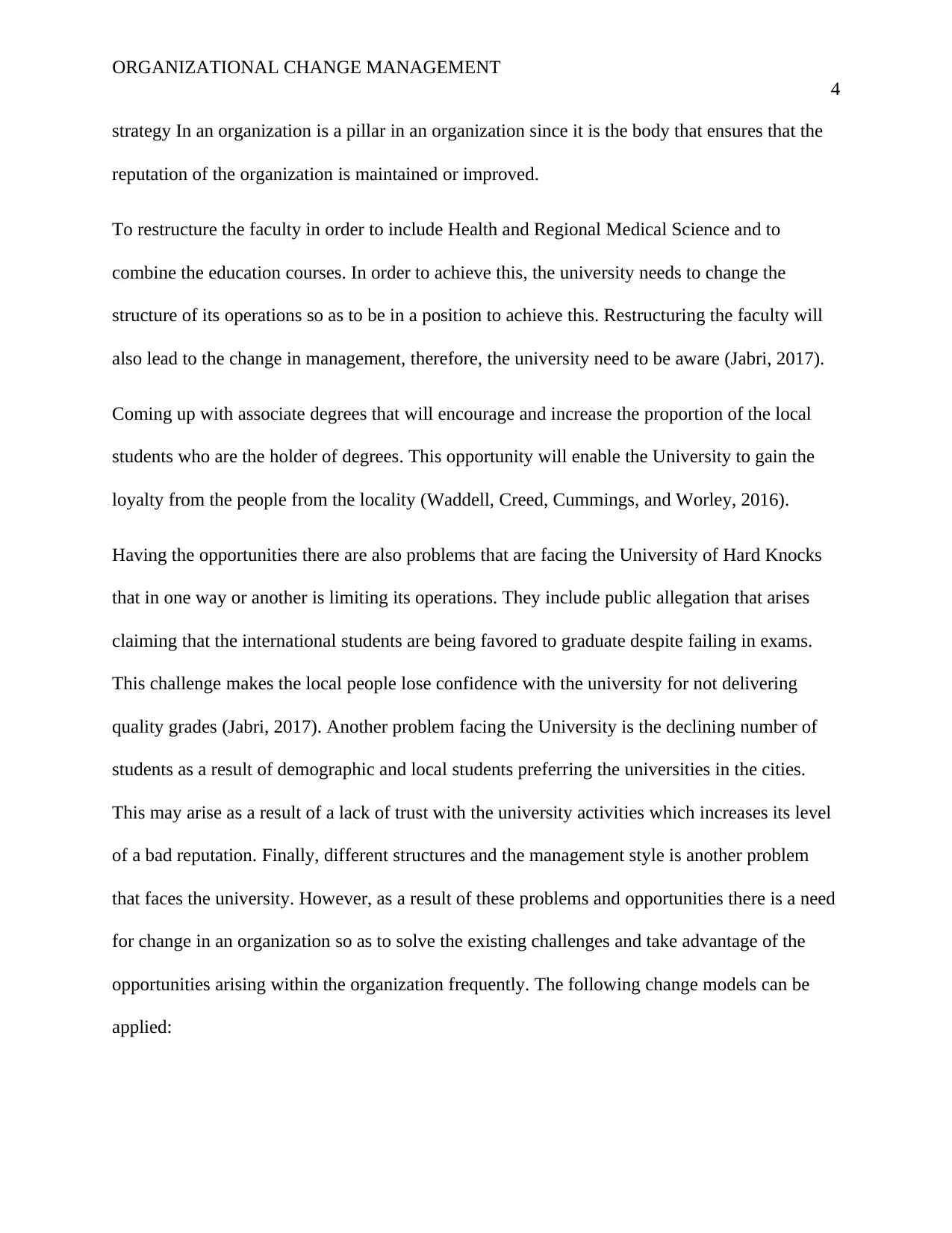
ORGANIZATIONAL CHANGE MANAGEMENT
4
strategy In an organization is a pillar in an organization since it is the body that ensures that the
reputation of the organization is maintained or improved.
To restructure the faculty in order to include Health and Regional Medical Science and to
combine the education courses. In order to achieve this, the university needs to change the
structure of its operations so as to be in a position to achieve this. Restructuring the faculty will
also lead to the change in management, therefore, the university need to be aware (Jabri, 2017).
Coming up with associate degrees that will encourage and increase the proportion of the local
students who are the holder of degrees. This opportunity will enable the University to gain the
loyalty from the people from the locality (Waddell, Creed, Cummings, and Worley, 2016).
Having the opportunities there are also problems that are facing the University of Hard Knocks
that in one way or another is limiting its operations. They include public allegation that arises
claiming that the international students are being favored to graduate despite failing in exams.
This challenge makes the local people lose confidence with the university for not delivering
quality grades (Jabri, 2017). Another problem facing the University is the declining number of
students as a result of demographic and local students preferring the universities in the cities.
This may arise as a result of a lack of trust with the university activities which increases its level
of a bad reputation. Finally, different structures and the management style is another problem
that faces the university. However, as a result of these problems and opportunities there is a need
for change in an organization so as to solve the existing challenges and take advantage of the
opportunities arising within the organization frequently. The following change models can be
applied:
4
strategy In an organization is a pillar in an organization since it is the body that ensures that the
reputation of the organization is maintained or improved.
To restructure the faculty in order to include Health and Regional Medical Science and to
combine the education courses. In order to achieve this, the university needs to change the
structure of its operations so as to be in a position to achieve this. Restructuring the faculty will
also lead to the change in management, therefore, the university need to be aware (Jabri, 2017).
Coming up with associate degrees that will encourage and increase the proportion of the local
students who are the holder of degrees. This opportunity will enable the University to gain the
loyalty from the people from the locality (Waddell, Creed, Cummings, and Worley, 2016).
Having the opportunities there are also problems that are facing the University of Hard Knocks
that in one way or another is limiting its operations. They include public allegation that arises
claiming that the international students are being favored to graduate despite failing in exams.
This challenge makes the local people lose confidence with the university for not delivering
quality grades (Jabri, 2017). Another problem facing the University is the declining number of
students as a result of demographic and local students preferring the universities in the cities.
This may arise as a result of a lack of trust with the university activities which increases its level
of a bad reputation. Finally, different structures and the management style is another problem
that faces the university. However, as a result of these problems and opportunities there is a need
for change in an organization so as to solve the existing challenges and take advantage of the
opportunities arising within the organization frequently. The following change models can be
applied:
Paraphrase This Document
Need a fresh take? Get an instant paraphrase of this document with our AI Paraphraser
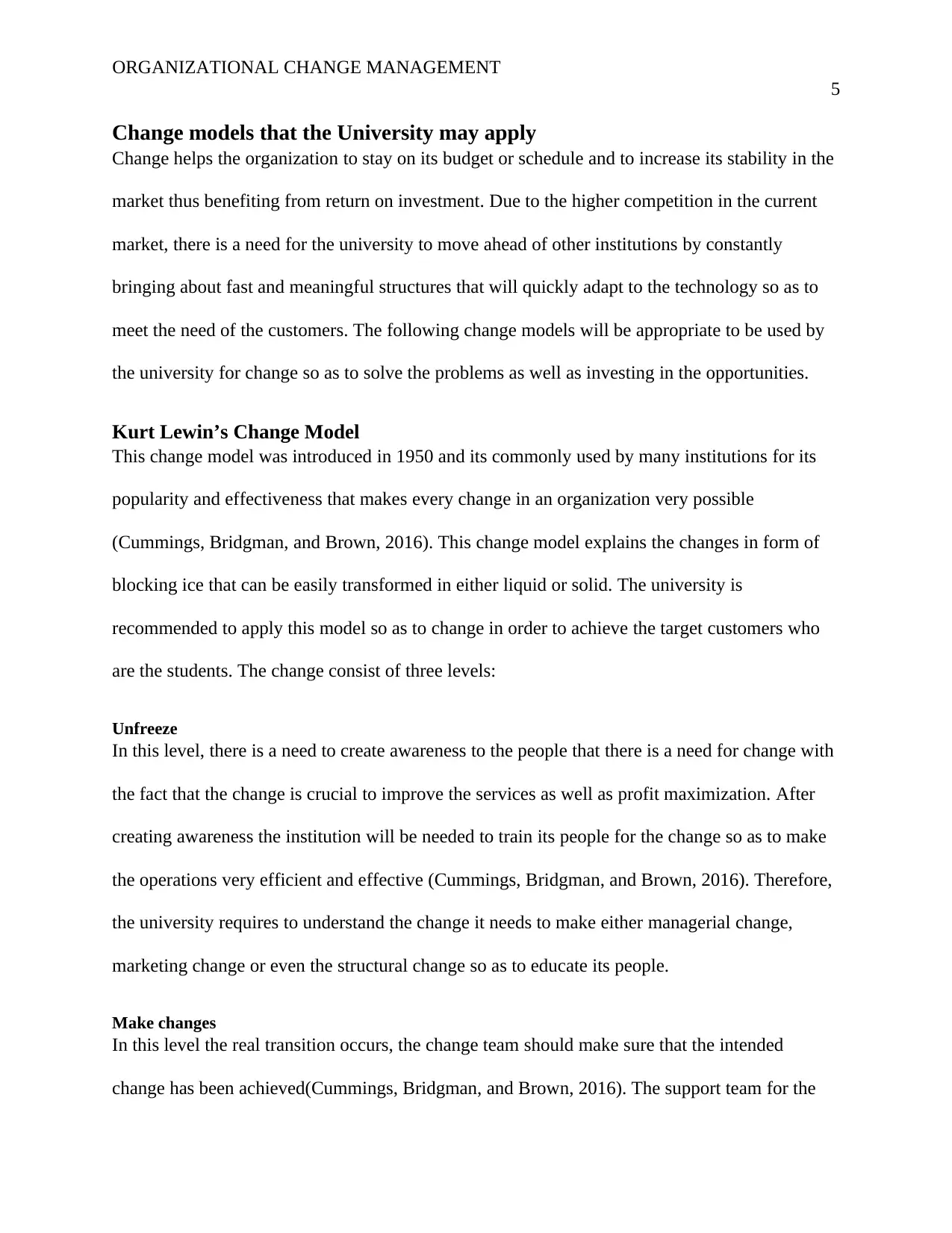
ORGANIZATIONAL CHANGE MANAGEMENT
5
Change models that the University may apply
Change helps the organization to stay on its budget or schedule and to increase its stability in the
market thus benefiting from return on investment. Due to the higher competition in the current
market, there is a need for the university to move ahead of other institutions by constantly
bringing about fast and meaningful structures that will quickly adapt to the technology so as to
meet the need of the customers. The following change models will be appropriate to be used by
the university for change so as to solve the problems as well as investing in the opportunities.
Kurt Lewin’s Change Model
This change model was introduced in 1950 and its commonly used by many institutions for its
popularity and effectiveness that makes every change in an organization very possible
(Cummings, Bridgman, and Brown, 2016). This change model explains the changes in form of
blocking ice that can be easily transformed in either liquid or solid. The university is
recommended to apply this model so as to change in order to achieve the target customers who
are the students. The change consist of three levels:
Unfreeze
In this level, there is a need to create awareness to the people that there is a need for change with
the fact that the change is crucial to improve the services as well as profit maximization. After
creating awareness the institution will be needed to train its people for the change so as to make
the operations very efficient and effective (Cummings, Bridgman, and Brown, 2016). Therefore,
the university requires to understand the change it needs to make either managerial change,
marketing change or even the structural change so as to educate its people.
Make changes
In this level the real transition occurs, the change team should make sure that the intended
change has been achieved(Cummings, Bridgman, and Brown, 2016). The support team for the
5
Change models that the University may apply
Change helps the organization to stay on its budget or schedule and to increase its stability in the
market thus benefiting from return on investment. Due to the higher competition in the current
market, there is a need for the university to move ahead of other institutions by constantly
bringing about fast and meaningful structures that will quickly adapt to the technology so as to
meet the need of the customers. The following change models will be appropriate to be used by
the university for change so as to solve the problems as well as investing in the opportunities.
Kurt Lewin’s Change Model
This change model was introduced in 1950 and its commonly used by many institutions for its
popularity and effectiveness that makes every change in an organization very possible
(Cummings, Bridgman, and Brown, 2016). This change model explains the changes in form of
blocking ice that can be easily transformed in either liquid or solid. The university is
recommended to apply this model so as to change in order to achieve the target customers who
are the students. The change consist of three levels:
Unfreeze
In this level, there is a need to create awareness to the people that there is a need for change with
the fact that the change is crucial to improve the services as well as profit maximization. After
creating awareness the institution will be needed to train its people for the change so as to make
the operations very efficient and effective (Cummings, Bridgman, and Brown, 2016). Therefore,
the university requires to understand the change it needs to make either managerial change,
marketing change or even the structural change so as to educate its people.
Make changes
In this level the real transition occurs, the change team should make sure that the intended
change has been achieved(Cummings, Bridgman, and Brown, 2016). The support team for the
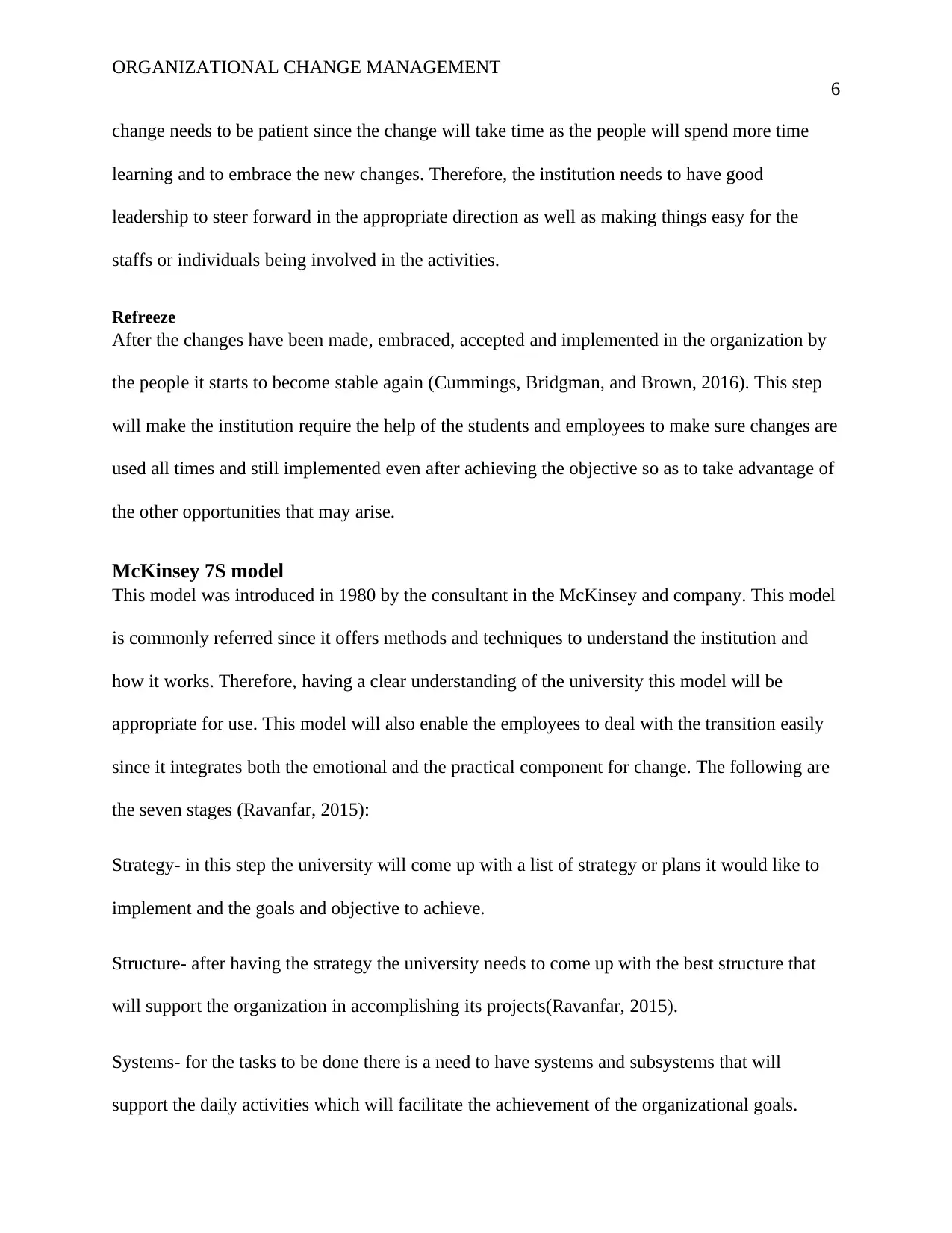
ORGANIZATIONAL CHANGE MANAGEMENT
6
change needs to be patient since the change will take time as the people will spend more time
learning and to embrace the new changes. Therefore, the institution needs to have good
leadership to steer forward in the appropriate direction as well as making things easy for the
staffs or individuals being involved in the activities.
Refreeze
After the changes have been made, embraced, accepted and implemented in the organization by
the people it starts to become stable again (Cummings, Bridgman, and Brown, 2016). This step
will make the institution require the help of the students and employees to make sure changes are
used all times and still implemented even after achieving the objective so as to take advantage of
the other opportunities that may arise.
McKinsey 7S model
This model was introduced in 1980 by the consultant in the McKinsey and company. This model
is commonly referred since it offers methods and techniques to understand the institution and
how it works. Therefore, having a clear understanding of the university this model will be
appropriate for use. This model will also enable the employees to deal with the transition easily
since it integrates both the emotional and the practical component for change. The following are
the seven stages (Ravanfar, 2015):
Strategy- in this step the university will come up with a list of strategy or plans it would like to
implement and the goals and objective to achieve.
Structure- after having the strategy the university needs to come up with the best structure that
will support the organization in accomplishing its projects(Ravanfar, 2015).
Systems- for the tasks to be done there is a need to have systems and subsystems that will
support the daily activities which will facilitate the achievement of the organizational goals.
6
change needs to be patient since the change will take time as the people will spend more time
learning and to embrace the new changes. Therefore, the institution needs to have good
leadership to steer forward in the appropriate direction as well as making things easy for the
staffs or individuals being involved in the activities.
Refreeze
After the changes have been made, embraced, accepted and implemented in the organization by
the people it starts to become stable again (Cummings, Bridgman, and Brown, 2016). This step
will make the institution require the help of the students and employees to make sure changes are
used all times and still implemented even after achieving the objective so as to take advantage of
the other opportunities that may arise.
McKinsey 7S model
This model was introduced in 1980 by the consultant in the McKinsey and company. This model
is commonly referred since it offers methods and techniques to understand the institution and
how it works. Therefore, having a clear understanding of the university this model will be
appropriate for use. This model will also enable the employees to deal with the transition easily
since it integrates both the emotional and the practical component for change. The following are
the seven stages (Ravanfar, 2015):
Strategy- in this step the university will come up with a list of strategy or plans it would like to
implement and the goals and objective to achieve.
Structure- after having the strategy the university needs to come up with the best structure that
will support the organization in accomplishing its projects(Ravanfar, 2015).
Systems- for the tasks to be done there is a need to have systems and subsystems that will
support the daily activities which will facilitate the achievement of the organizational goals.
⊘ This is a preview!⊘
Do you want full access?
Subscribe today to unlock all pages.

Trusted by 1+ million students worldwide
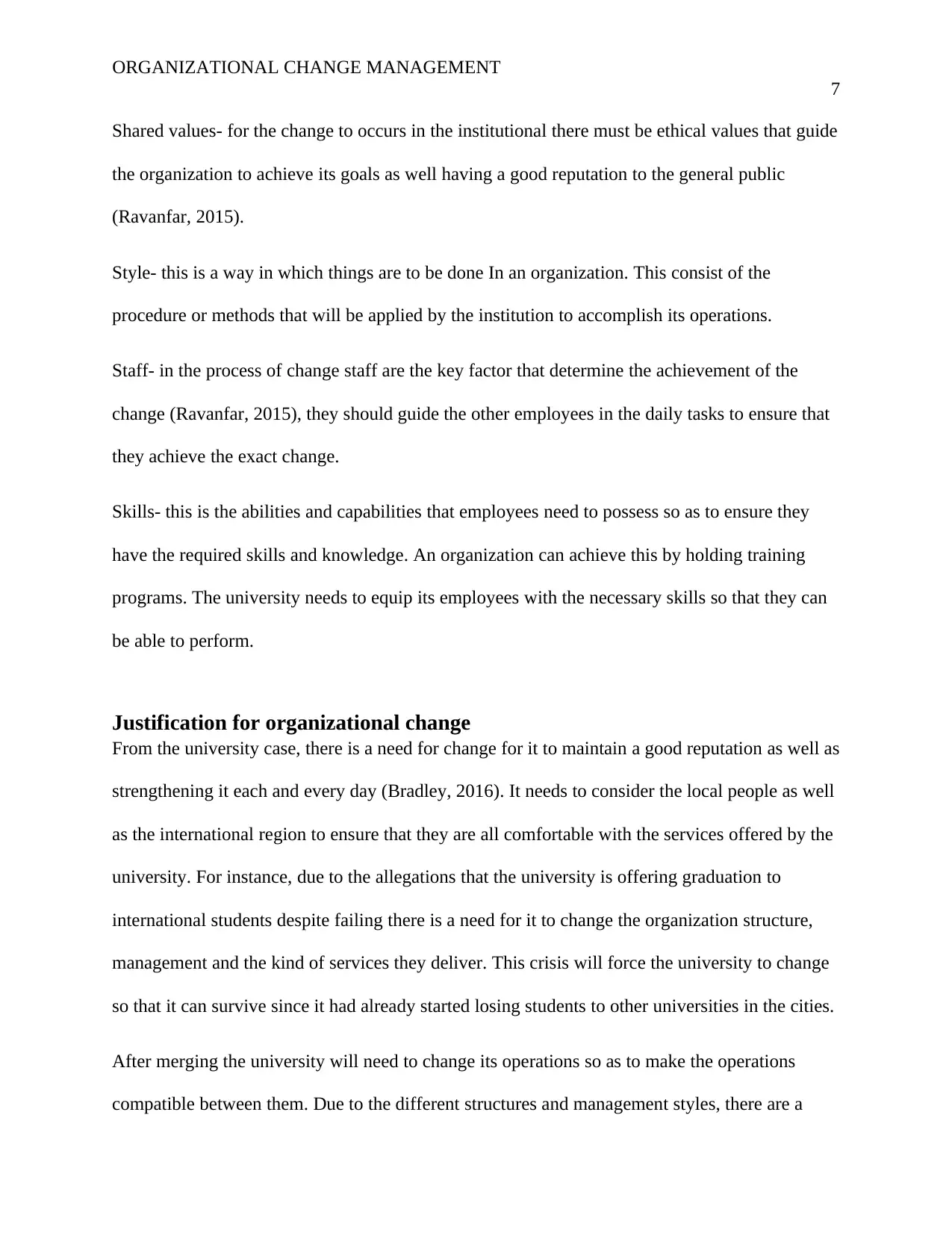
ORGANIZATIONAL CHANGE MANAGEMENT
7
Shared values- for the change to occurs in the institutional there must be ethical values that guide
the organization to achieve its goals as well having a good reputation to the general public
(Ravanfar, 2015).
Style- this is a way in which things are to be done In an organization. This consist of the
procedure or methods that will be applied by the institution to accomplish its operations.
Staff- in the process of change staff are the key factor that determine the achievement of the
change (Ravanfar, 2015), they should guide the other employees in the daily tasks to ensure that
they achieve the exact change.
Skills- this is the abilities and capabilities that employees need to possess so as to ensure they
have the required skills and knowledge. An organization can achieve this by holding training
programs. The university needs to equip its employees with the necessary skills so that they can
be able to perform.
Justification for organizational change
From the university case, there is a need for change for it to maintain a good reputation as well as
strengthening it each and every day (Bradley, 2016). It needs to consider the local people as well
as the international region to ensure that they are all comfortable with the services offered by the
university. For instance, due to the allegations that the university is offering graduation to
international students despite failing there is a need for it to change the organization structure,
management and the kind of services they deliver. This crisis will force the university to change
so that it can survive since it had already started losing students to other universities in the cities.
After merging the university will need to change its operations so as to make the operations
compatible between them. Due to the different structures and management styles, there are a
7
Shared values- for the change to occurs in the institutional there must be ethical values that guide
the organization to achieve its goals as well having a good reputation to the general public
(Ravanfar, 2015).
Style- this is a way in which things are to be done In an organization. This consist of the
procedure or methods that will be applied by the institution to accomplish its operations.
Staff- in the process of change staff are the key factor that determine the achievement of the
change (Ravanfar, 2015), they should guide the other employees in the daily tasks to ensure that
they achieve the exact change.
Skills- this is the abilities and capabilities that employees need to possess so as to ensure they
have the required skills and knowledge. An organization can achieve this by holding training
programs. The university needs to equip its employees with the necessary skills so that they can
be able to perform.
Justification for organizational change
From the university case, there is a need for change for it to maintain a good reputation as well as
strengthening it each and every day (Bradley, 2016). It needs to consider the local people as well
as the international region to ensure that they are all comfortable with the services offered by the
university. For instance, due to the allegations that the university is offering graduation to
international students despite failing there is a need for it to change the organization structure,
management and the kind of services they deliver. This crisis will force the university to change
so that it can survive since it had already started losing students to other universities in the cities.
After merging the university will need to change its operations so as to make the operations
compatible between them. Due to the different structures and management styles, there are a
Paraphrase This Document
Need a fresh take? Get an instant paraphrase of this document with our AI Paraphraser
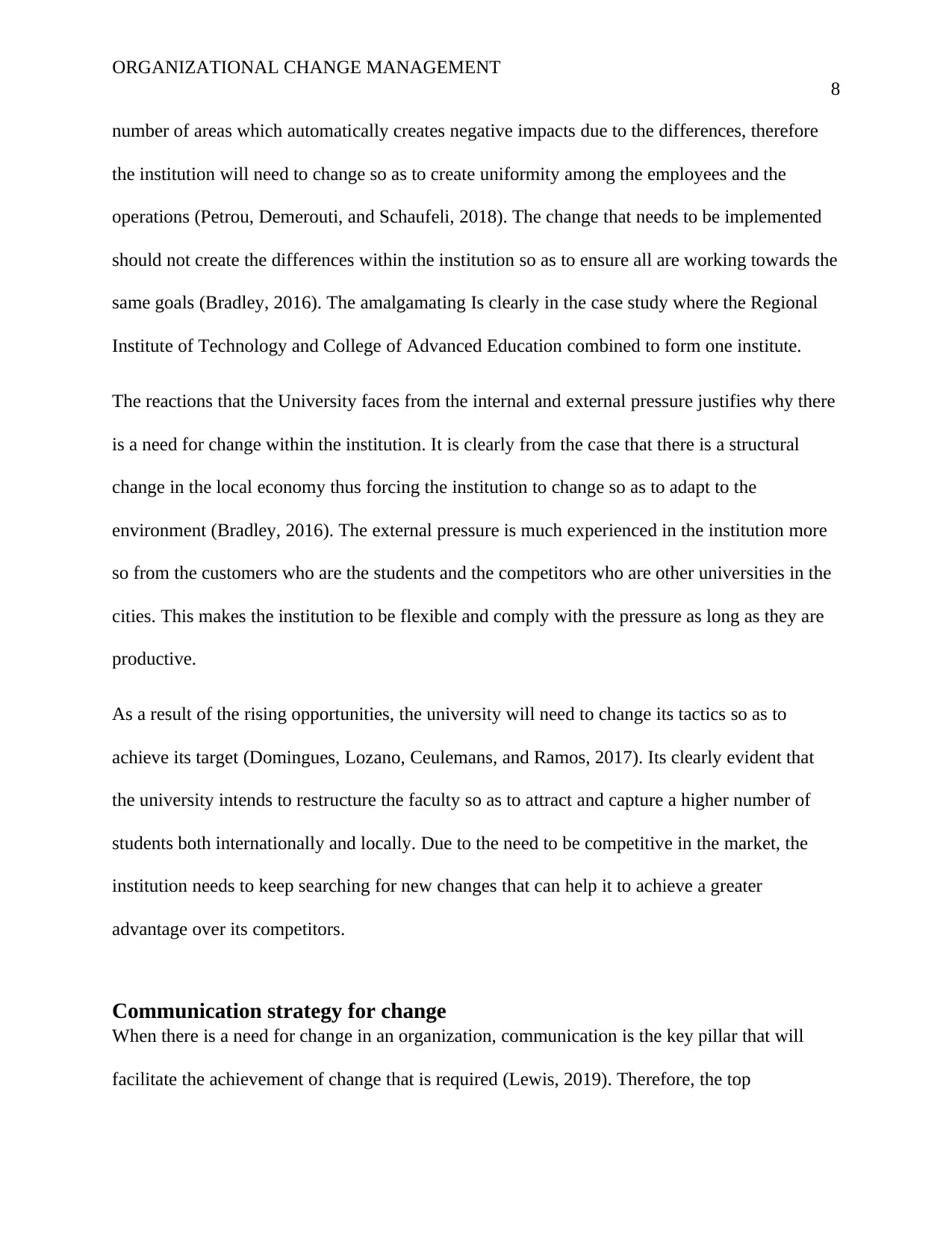
ORGANIZATIONAL CHANGE MANAGEMENT
8
number of areas which automatically creates negative impacts due to the differences, therefore
the institution will need to change so as to create uniformity among the employees and the
operations (Petrou, Demerouti, and Schaufeli, 2018). The change that needs to be implemented
should not create the differences within the institution so as to ensure all are working towards the
same goals (Bradley, 2016). The amalgamating Is clearly in the case study where the Regional
Institute of Technology and College of Advanced Education combined to form one institute.
The reactions that the University faces from the internal and external pressure justifies why there
is a need for change within the institution. It is clearly from the case that there is a structural
change in the local economy thus forcing the institution to change so as to adapt to the
environment (Bradley, 2016). The external pressure is much experienced in the institution more
so from the customers who are the students and the competitors who are other universities in the
cities. This makes the institution to be flexible and comply with the pressure as long as they are
productive.
As a result of the rising opportunities, the university will need to change its tactics so as to
achieve its target (Domingues, Lozano, Ceulemans, and Ramos, 2017). Its clearly evident that
the university intends to restructure the faculty so as to attract and capture a higher number of
students both internationally and locally. Due to the need to be competitive in the market, the
institution needs to keep searching for new changes that can help it to achieve a greater
advantage over its competitors.
Communication strategy for change
When there is a need for change in an organization, communication is the key pillar that will
facilitate the achievement of change that is required (Lewis, 2019). Therefore, the top
8
number of areas which automatically creates negative impacts due to the differences, therefore
the institution will need to change so as to create uniformity among the employees and the
operations (Petrou, Demerouti, and Schaufeli, 2018). The change that needs to be implemented
should not create the differences within the institution so as to ensure all are working towards the
same goals (Bradley, 2016). The amalgamating Is clearly in the case study where the Regional
Institute of Technology and College of Advanced Education combined to form one institute.
The reactions that the University faces from the internal and external pressure justifies why there
is a need for change within the institution. It is clearly from the case that there is a structural
change in the local economy thus forcing the institution to change so as to adapt to the
environment (Bradley, 2016). The external pressure is much experienced in the institution more
so from the customers who are the students and the competitors who are other universities in the
cities. This makes the institution to be flexible and comply with the pressure as long as they are
productive.
As a result of the rising opportunities, the university will need to change its tactics so as to
achieve its target (Domingues, Lozano, Ceulemans, and Ramos, 2017). Its clearly evident that
the university intends to restructure the faculty so as to attract and capture a higher number of
students both internationally and locally. Due to the need to be competitive in the market, the
institution needs to keep searching for new changes that can help it to achieve a greater
advantage over its competitors.
Communication strategy for change
When there is a need for change in an organization, communication is the key pillar that will
facilitate the achievement of change that is required (Lewis, 2019). Therefore, the top
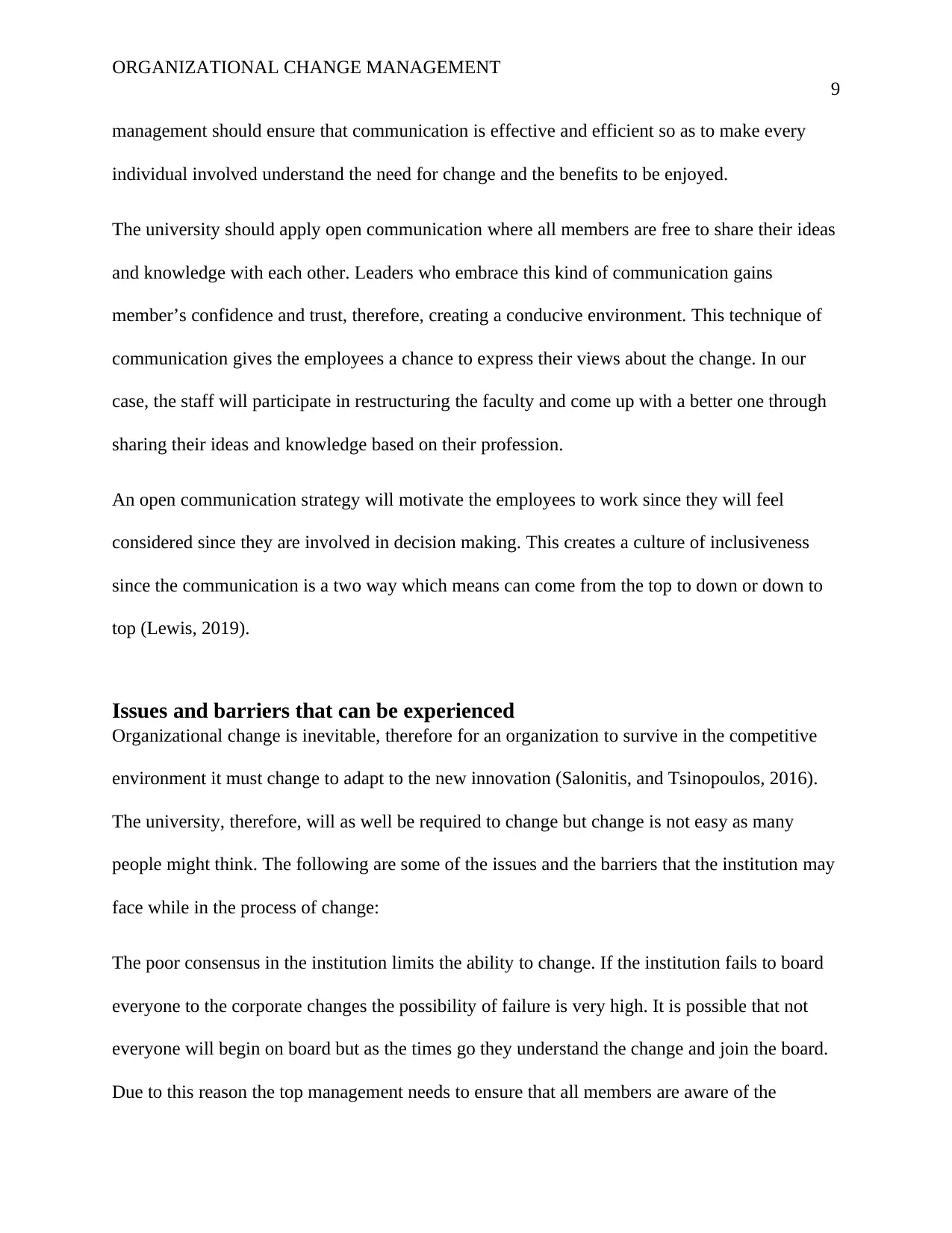
ORGANIZATIONAL CHANGE MANAGEMENT
9
management should ensure that communication is effective and efficient so as to make every
individual involved understand the need for change and the benefits to be enjoyed.
The university should apply open communication where all members are free to share their ideas
and knowledge with each other. Leaders who embrace this kind of communication gains
member’s confidence and trust, therefore, creating a conducive environment. This technique of
communication gives the employees a chance to express their views about the change. In our
case, the staff will participate in restructuring the faculty and come up with a better one through
sharing their ideas and knowledge based on their profession.
An open communication strategy will motivate the employees to work since they will feel
considered since they are involved in decision making. This creates a culture of inclusiveness
since the communication is a two way which means can come from the top to down or down to
top (Lewis, 2019).
Issues and barriers that can be experienced
Organizational change is inevitable, therefore for an organization to survive in the competitive
environment it must change to adapt to the new innovation (Salonitis, and Tsinopoulos, 2016).
The university, therefore, will as well be required to change but change is not easy as many
people might think. The following are some of the issues and the barriers that the institution may
face while in the process of change:
The poor consensus in the institution limits the ability to change. If the institution fails to board
everyone to the corporate changes the possibility of failure is very high. It is possible that not
everyone will begin on board but as the times go they understand the change and join the board.
Due to this reason the top management needs to ensure that all members are aware of the
9
management should ensure that communication is effective and efficient so as to make every
individual involved understand the need for change and the benefits to be enjoyed.
The university should apply open communication where all members are free to share their ideas
and knowledge with each other. Leaders who embrace this kind of communication gains
member’s confidence and trust, therefore, creating a conducive environment. This technique of
communication gives the employees a chance to express their views about the change. In our
case, the staff will participate in restructuring the faculty and come up with a better one through
sharing their ideas and knowledge based on their profession.
An open communication strategy will motivate the employees to work since they will feel
considered since they are involved in decision making. This creates a culture of inclusiveness
since the communication is a two way which means can come from the top to down or down to
top (Lewis, 2019).
Issues and barriers that can be experienced
Organizational change is inevitable, therefore for an organization to survive in the competitive
environment it must change to adapt to the new innovation (Salonitis, and Tsinopoulos, 2016).
The university, therefore, will as well be required to change but change is not easy as many
people might think. The following are some of the issues and the barriers that the institution may
face while in the process of change:
The poor consensus in the institution limits the ability to change. If the institution fails to board
everyone to the corporate changes the possibility of failure is very high. It is possible that not
everyone will begin on board but as the times go they understand the change and join the board.
Due to this reason the top management needs to ensure that all members are aware of the
⊘ This is a preview!⊘
Do you want full access?
Subscribe today to unlock all pages.

Trusted by 1+ million students worldwide
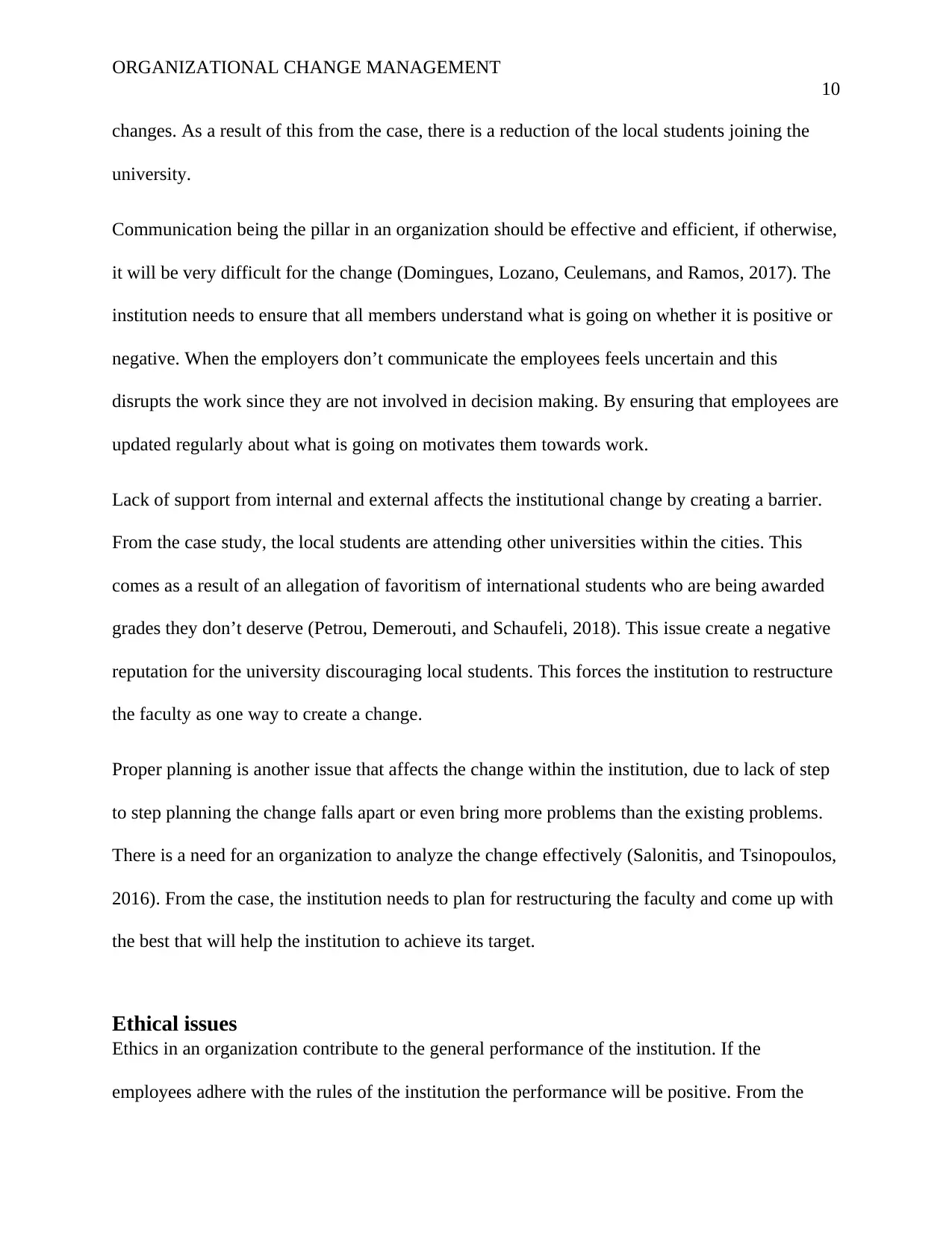
ORGANIZATIONAL CHANGE MANAGEMENT
10
changes. As a result of this from the case, there is a reduction of the local students joining the
university.
Communication being the pillar in an organization should be effective and efficient, if otherwise,
it will be very difficult for the change (Domingues, Lozano, Ceulemans, and Ramos, 2017). The
institution needs to ensure that all members understand what is going on whether it is positive or
negative. When the employers don’t communicate the employees feels uncertain and this
disrupts the work since they are not involved in decision making. By ensuring that employees are
updated regularly about what is going on motivates them towards work.
Lack of support from internal and external affects the institutional change by creating a barrier.
From the case study, the local students are attending other universities within the cities. This
comes as a result of an allegation of favoritism of international students who are being awarded
grades they don’t deserve (Petrou, Demerouti, and Schaufeli, 2018). This issue create a negative
reputation for the university discouraging local students. This forces the institution to restructure
the faculty as one way to create a change.
Proper planning is another issue that affects the change within the institution, due to lack of step
to step planning the change falls apart or even bring more problems than the existing problems.
There is a need for an organization to analyze the change effectively (Salonitis, and Tsinopoulos,
2016). From the case, the institution needs to plan for restructuring the faculty and come up with
the best that will help the institution to achieve its target.
Ethical issues
Ethics in an organization contribute to the general performance of the institution. If the
employees adhere with the rules of the institution the performance will be positive. From the
10
changes. As a result of this from the case, there is a reduction of the local students joining the
university.
Communication being the pillar in an organization should be effective and efficient, if otherwise,
it will be very difficult for the change (Domingues, Lozano, Ceulemans, and Ramos, 2017). The
institution needs to ensure that all members understand what is going on whether it is positive or
negative. When the employers don’t communicate the employees feels uncertain and this
disrupts the work since they are not involved in decision making. By ensuring that employees are
updated regularly about what is going on motivates them towards work.
Lack of support from internal and external affects the institutional change by creating a barrier.
From the case study, the local students are attending other universities within the cities. This
comes as a result of an allegation of favoritism of international students who are being awarded
grades they don’t deserve (Petrou, Demerouti, and Schaufeli, 2018). This issue create a negative
reputation for the university discouraging local students. This forces the institution to restructure
the faculty as one way to create a change.
Proper planning is another issue that affects the change within the institution, due to lack of step
to step planning the change falls apart or even bring more problems than the existing problems.
There is a need for an organization to analyze the change effectively (Salonitis, and Tsinopoulos,
2016). From the case, the institution needs to plan for restructuring the faculty and come up with
the best that will help the institution to achieve its target.
Ethical issues
Ethics in an organization contribute to the general performance of the institution. If the
employees adhere with the rules of the institution the performance will be positive. From the
Paraphrase This Document
Need a fresh take? Get an instant paraphrase of this document with our AI Paraphraser
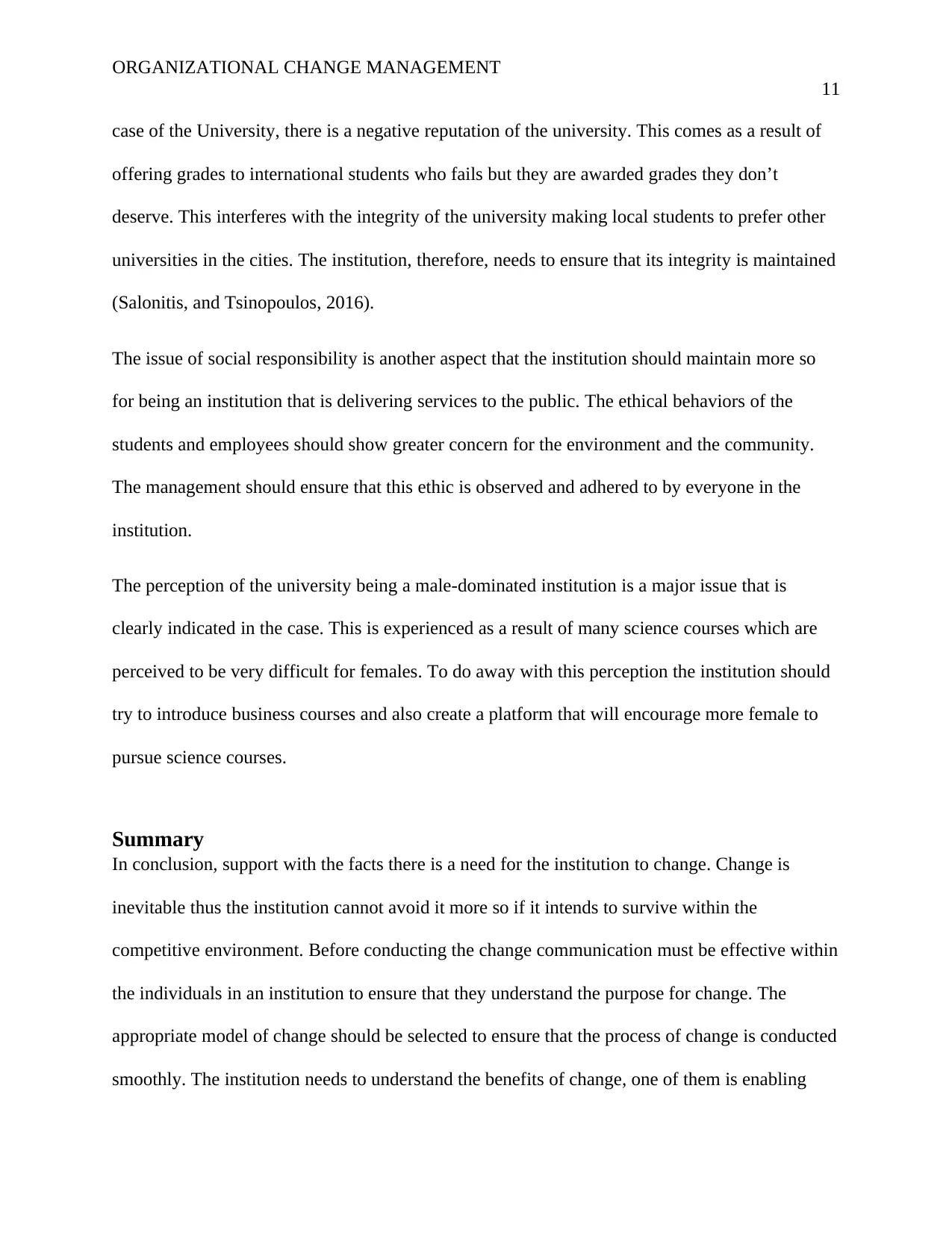
ORGANIZATIONAL CHANGE MANAGEMENT
11
case of the University, there is a negative reputation of the university. This comes as a result of
offering grades to international students who fails but they are awarded grades they don’t
deserve. This interferes with the integrity of the university making local students to prefer other
universities in the cities. The institution, therefore, needs to ensure that its integrity is maintained
(Salonitis, and Tsinopoulos, 2016).
The issue of social responsibility is another aspect that the institution should maintain more so
for being an institution that is delivering services to the public. The ethical behaviors of the
students and employees should show greater concern for the environment and the community.
The management should ensure that this ethic is observed and adhered to by everyone in the
institution.
The perception of the university being a male-dominated institution is a major issue that is
clearly indicated in the case. This is experienced as a result of many science courses which are
perceived to be very difficult for females. To do away with this perception the institution should
try to introduce business courses and also create a platform that will encourage more female to
pursue science courses.
Summary
In conclusion, support with the facts there is a need for the institution to change. Change is
inevitable thus the institution cannot avoid it more so if it intends to survive within the
competitive environment. Before conducting the change communication must be effective within
the individuals in an institution to ensure that they understand the purpose for change. The
appropriate model of change should be selected to ensure that the process of change is conducted
smoothly. The institution needs to understand the benefits of change, one of them is enabling
11
case of the University, there is a negative reputation of the university. This comes as a result of
offering grades to international students who fails but they are awarded grades they don’t
deserve. This interferes with the integrity of the university making local students to prefer other
universities in the cities. The institution, therefore, needs to ensure that its integrity is maintained
(Salonitis, and Tsinopoulos, 2016).
The issue of social responsibility is another aspect that the institution should maintain more so
for being an institution that is delivering services to the public. The ethical behaviors of the
students and employees should show greater concern for the environment and the community.
The management should ensure that this ethic is observed and adhered to by everyone in the
institution.
The perception of the university being a male-dominated institution is a major issue that is
clearly indicated in the case. This is experienced as a result of many science courses which are
perceived to be very difficult for females. To do away with this perception the institution should
try to introduce business courses and also create a platform that will encourage more female to
pursue science courses.
Summary
In conclusion, support with the facts there is a need for the institution to change. Change is
inevitable thus the institution cannot avoid it more so if it intends to survive within the
competitive environment. Before conducting the change communication must be effective within
the individuals in an institution to ensure that they understand the purpose for change. The
appropriate model of change should be selected to ensure that the process of change is conducted
smoothly. The institution needs to understand the benefits of change, one of them is enabling
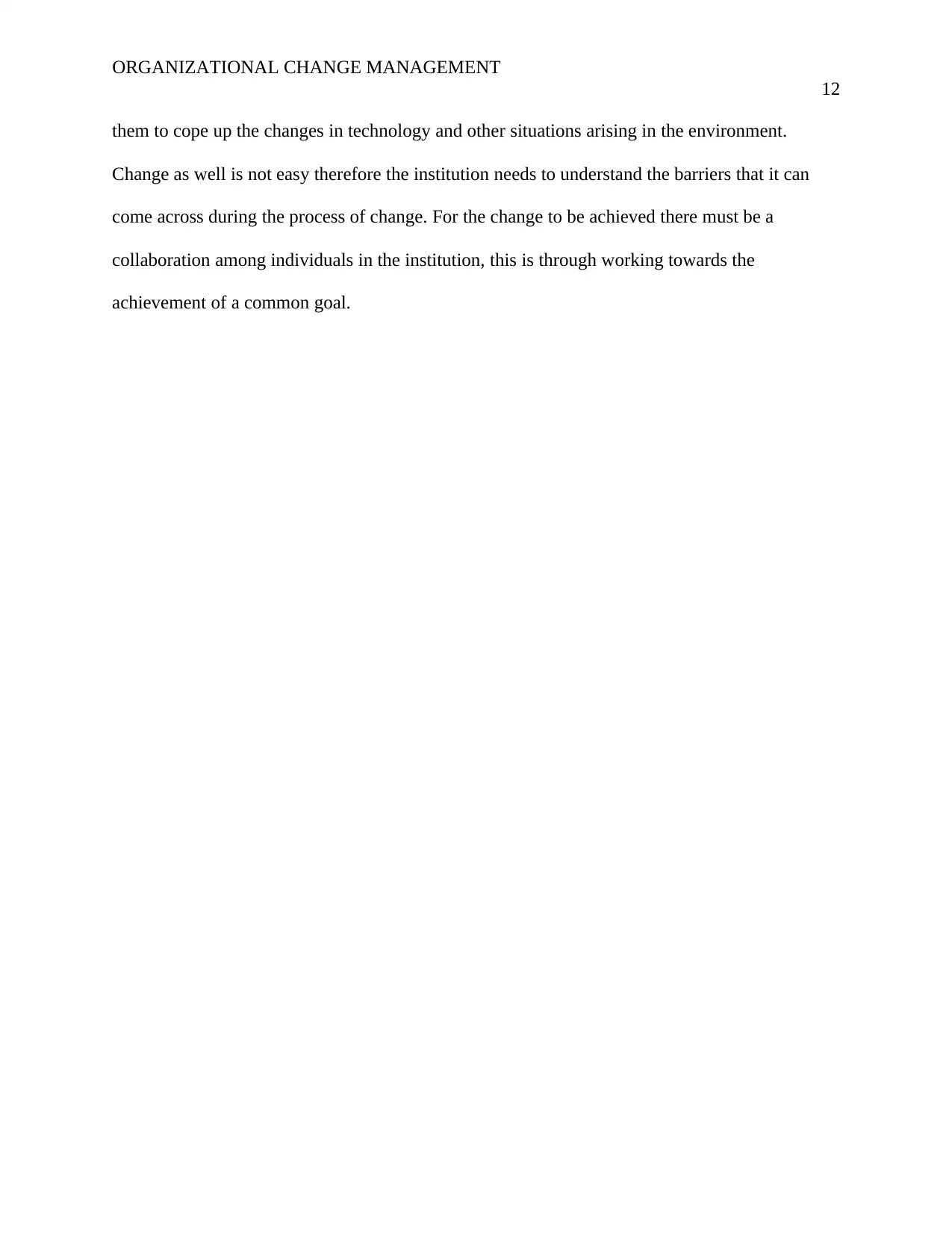
ORGANIZATIONAL CHANGE MANAGEMENT
12
them to cope up the changes in technology and other situations arising in the environment.
Change as well is not easy therefore the institution needs to understand the barriers that it can
come across during the process of change. For the change to be achieved there must be a
collaboration among individuals in the institution, this is through working towards the
achievement of a common goal.
12
them to cope up the changes in technology and other situations arising in the environment.
Change as well is not easy therefore the institution needs to understand the barriers that it can
come across during the process of change. For the change to be achieved there must be a
collaboration among individuals in the institution, this is through working towards the
achievement of a common goal.
⊘ This is a preview!⊘
Do you want full access?
Subscribe today to unlock all pages.

Trusted by 1+ million students worldwide
1 out of 14
Related Documents
Your All-in-One AI-Powered Toolkit for Academic Success.
+13062052269
info@desklib.com
Available 24*7 on WhatsApp / Email
![[object Object]](/_next/static/media/star-bottom.7253800d.svg)
Unlock your academic potential
Copyright © 2020–2025 A2Z Services. All Rights Reserved. Developed and managed by ZUCOL.




